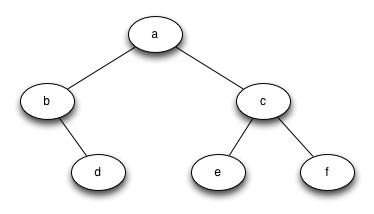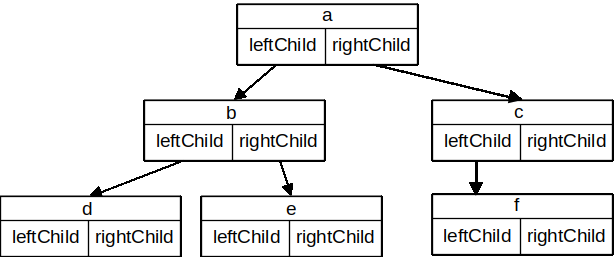1.
Write a method named
buildTree that returns a tree using the nodes and references implementation that looks like this:


leftChild and rightChild will become references to other instances of the BinaryTree class. For example, when we insert a new left child into the tree, we create another instance of BinaryTree and modify this.leftChild in the root to reference the new tree.
class BinaryTree<T> {
T key;
BinaryTree<T> leftChild;
BinaryTree<T> rightChild;
public BinaryTree(T rootObject) {
this.key = rootObject;
this.leftChild = null;
this.rightChild = null;
}
// more code here..
}
BinaryTree class.
leftChild attribute of the root to refer to this new object. The code for insertLeft is shown in Listing 6.6.3.
public void insertLeft(T newNode) {
if (this.leftChild == null) {
this.leftChild = new BinaryTree<T>(newNode);
} else {
BinaryTree<T> newChild = new BinaryTree<T>(newNode);
newChild.leftChild = this.leftChild;
this.leftChild = newChild;
}
}
else statement on line 4 of Listing 6.6.3.
insertRight must consider a symmetric set of cases. There will either be no right child, or we must insert the node between the root and an existing right child. The insertion code is shown in Listing 6.6.4.
public void insertRight(T newNode) {
if (this.rightChild == null) {
this.rightChild = new BinaryTree<T>(newNode);
} else {
BinaryTree<T> newChild = new BinaryTree<T>(newNode);
newChild.rightChild = this.rightChild;
this.rightChild = newChild;
}
}
public T getRootValue() {
return this.key;
}
public void setRootValue(T value) {
this.key = value;
}
public BinaryTree<T> getLeftChild() {
return this.leftChild;
}
public BinaryTree<T> getRightChild() {
return this.rightChild;
}
key, leftChild, and rightChild. Notice that both the left and right children of the root are themselves distinct instances of the BinaryTree class. As we said in our original recursive definition for a tree, this allows us to treat any child of a binary tree as a binary tree itself.
BinaryTree ClassbuildTree that returns a tree using the nodes and references implementation that looks like this:
